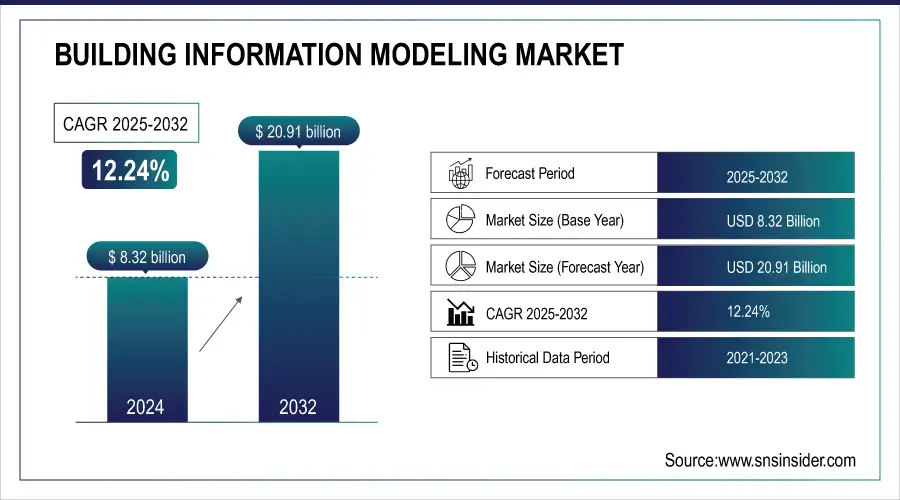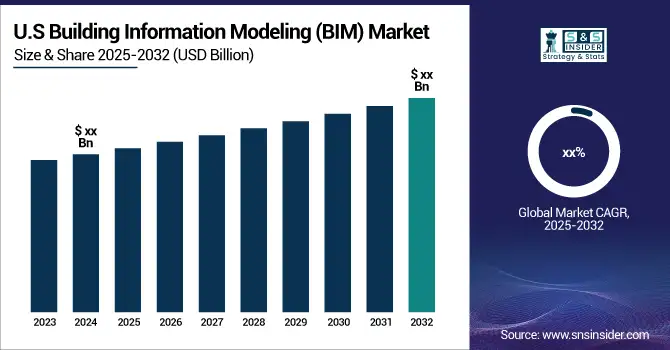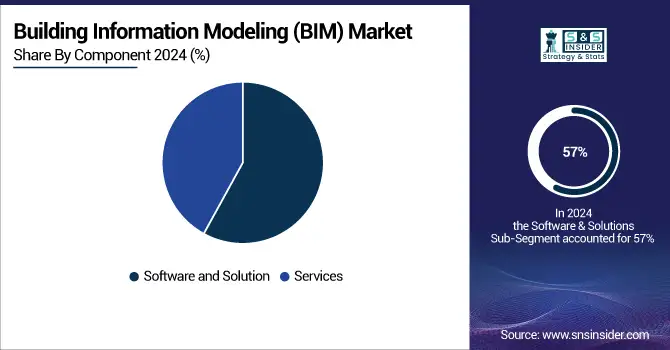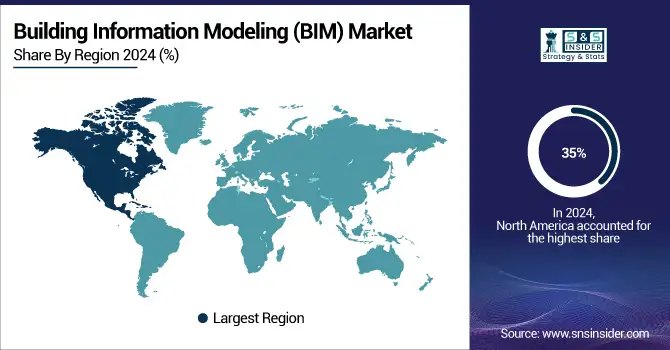Building Information Modeling (BIM) Market Size & Trends:
The Building Information Modeling Market size was valued at USD 8.32 Billion in 2025E It is estimated to reach USD 20.91 Billion by 2033, growing at a CAGR of 12.24% during 2026-2033. Building Information Modeling market analysis is highlighting how BIM is transforming the architecture, engineering, and construction (AEC) sectors through providing a detailed digital depiction of a building's physical and functional features. In recent years, there has been substantial growth in the building information modeling (BIM) market, fueled by the rising demand for improved project management, cost cuts, and increased productivity in the AEC sectors.
Building Information Modeling Market Size and Forecast:
-
Market Size in 2025E: USD 8.32 Billion
-
Market Size by 2033: USD 20.91 Billion
-
CAGR: 12.24% (from 2026 to 2033)
-
Base Year: 2025
-
Forecast Period: 2026–2033
-
Historical Data: 2022–2024

Get more information on Building Information Modeling Market - Request Sample Report
The U.S. Building Information Modeling (BIM) market size was valued at an estimated USD 3.10 billion in 2025 and is projected to reach USD 7.95 billion by 2033, growing at a CAGR of 12.1% over the forecast period 2026–2033. Market growth is driven by increasing adoption of digital construction technologies, rising demand for efficient project planning and cost optimization, and growing infrastructure development across commercial, residential, and industrial sectors. Strong implementation of BIM in architecture, engineering, and construction (AEC) firms, supported by government mandates for public infrastructure projects and rising investments in smart cities, is accelerating market expansion. Additionally, advancements in cloud-based BIM solutions, integration with AI and IoT technologies, and growing focus on sustainability and lifecycle asset management further strengthen the growth outlook of the U.S. BIM market during the forecast period.

Emerging Trends Shaping the Global Building Information Modeling Market
-
Governments worldwide are mandating BIM for large-scale public projects, driving adoption and standardization.
-
BIM enhances project efficiency, reduces construction time, costs, and errors through improved planning and resource management.
-
International standards like ISO 19650 promote a unified, standardized approach for cross-border construction operations.
-
3D visualization in BIM improves collaboration, communication, and alignment among architects, engineers, contractors, and clients.
-
Common data environments and digital models enable accurate, timely data sharing, facilitating project coordination, maintenance, and operations.
BIM Technology Market Drivers:
-
Global Government Mandates Driving the Growth of Building Information Modeling in Construction
Building Information Modeling market trends has gained the recognition of governments globally. The technology’s ability to improve construction projects’ efficiency and transparency has made government BIM mandates some of the most prominent market drivers in many countries and regions. For instance, the European Union issued BIM directives that apply to public works, and countries including the U.K. and Singapore have made BIM mandatory for large-scale public projects. Commonly, these mandates are issued with the specific purpose of ensuring increased standardization and decreased costs and errors throughout the construction and post-construction stages.
The abovementioned trend is one of the most important building information modeling market drivers as it pressures the construction sector to comply with modern technological standards. As a result, it leads to BIM software and services increased demand. This is especially relevant in those regions with the most stringent governmental BIM technology policies, which strictly enforce the technology’s use by contractors, architecture practices, and construction companies.
The benefits of these policies are extensive. First, they reduce the time pace of construction, and, subsequently, the costs associated with the process. Second, they facilitate better resource management and planning that is also beneficial for the environment. Moreover, international efforts such as the ISO 19650 are creating a unified BIM standard capable of ensuring a standard-based approach to cross-border construction operations.
-
Enhancing Collaboration and Visualization Through Building Information Modeling Propel Market Expansion
Building Information Modeling can improve visualization and facilitate collaboration, being one of its primary benefits in a contemporary setting. BIM systems create a model of a building in a 3D environment, which can help architects, engineers, contractors, and clients to see the design from the same perspective. Therefore, one of the main assets of BIM is that it ensures better communication between various stakeholders, as it provides all parties with a shared vision of a project. Targeting visualization improvements, BIM minimizes the risks related to misunderstandings and miscommunication, promoting better alignment between stakeholders.
Another advantage of such a visualization focus is that it is easier for the model to be updated and refined, allowing people to work with more accurate and timely data. A BIM system is used in a common data environment, which leads to improvements in the communication processes. Up-to-date and integrated data use allows decision-makers at all stages of a project to avoid delays associated with miscommunications and other errors. For instance, visual data available in BIM can help coordinate contractors and subcontractors who do not speak the same languages. In addition to these benefits, the use of digital models can facilitate the operation and maintenance of buildings, helping facility managers to identify issues promptly and organize work on maintenance and repairs.
BIM Technology Market Restraints:
-
High Costs Hinder BIM Adoption Among Small and Medium-Sized Enterprises
Although BIM enables substantial long-term cost savings, the costs associated with buying BIM software and introducing it in the organization have remained high and therefore have hurt user adoption. Such small and medium-sized enterprises as SMEs constitute more than 99% of all construction companies. These companies do not have ample financial resources to afford to pay for expensive licensing and implementation costs. Firstly, BIM software is not cheap, and the systems using it must also comply with the necessary standards, so the costs of introducing BIM in the workplace include investment in new hardware and IT infrastructure.
Apart from the tangible costs, there are cultural costs and BIM implies a cultural shift in the work practices and business processes of a company. SMEs could not pay the high cost of BIM as the cost was the major barrier to entry for even small building companies that wanted to use the new technology.
Building Information Modeling Market Segmentation Outlook
By Component:
The software & solutions segment had a building information modeling market share of 57% in 2025 and it dominated the market. This section includes tools and platforms for creating, modeling, and overseeing construction projects in a digital setting. BIM software enable architects, engineers, and construction professionals to work together more efficiently through the development of detailed 3D building models. Autodesk (Revit) and Bentley Systems (OpenBuildings) are examples of firms that provide robust BIM software solutions. Their tools help streamline design processes and project management in sectors, such as construction and architecture.
The services segment is expected to experience the fastest growth rate during 2026-2033. It consists of consulting, implementing, training, and supporting services to assist companies in integrating and efficiently utilizing BIM technologies. The rise in construction project complexity and the need for skilled BIM professionals are driving this expansion. For instance, companies, such as AECOM and Trimble offer BIM services that assist firms in improving project workflows, managing data effectively, and meeting industry standards.

By Deployment Mode:
On-premises deployment held a major building information modeling market share of 56% in 2025 and led the market. Big construction companies and government entities frequently choose on-site options owing to the confidentiality of their data. This mode of deployment enables organizations to have full control over their infrastructure and data privacy. Nemetschek (Allplan) offers in-house BIM solutions for companies to retain data internally and have complete customization and control of their software environment.
Cloud deployment is accounted to have the fastest CAGR during 2026-2033, driven by its ability to scale easily, be flexible, and be accessed from remote locations. Real-time collaboration across teams spread out in different locations is made possible, leading to a notable enhancement in project efficiency. by having BIM data stored in the cloud, project stakeholders can access and change information instantly, making it easier to make informed decisions. Large firms, such as Autodesk and Bentley Systems provide cloud-based BIM solutions including BIM 360 and ProjectWise 365, which allow teams to efficiently oversee project data from design to construction.
By Project Lifecycle:
The preconstruction segment led the building information modeling market in 2025 with a 43% share. This stage emphasizes preparation, creation, and organization before the start of construction, guaranteeing that all parties involved comprehend the project fully. Utilizing BIM in preconstruction enhances visualization, clash detection, and cost estimation accuracy, leading to a decrease in errors and delays. Autodesk, along with its BIM 360 platform, offers tools that improve teamwork among architects, engineers, and contractors by enabling them to develop precise 3D models that guide decision-making at the beginning stages of a project.
The construction segment is expected to experience a rapid growth rate during 2026-2033, as it is vital for carrying out project designs. In this stage, BIM helps contractors, subcontractors, and field workers collaborate and communicate in real time to ensure alignment with project goals. Having the capability to view comprehensive 3D models at the location assists teams in visualizing intricate components, reducing misunderstandings, and improving efficiency. Moreover, combining BIM with construction management software improves workflow efficiency, quality control, and safety measures, ultimately boosting the construction phase's overall effectiveness.
Building Information Modeling Market Regional Analysis:
North America Building Information Modeling Market Insights
North America dominated the market in 2025 with a 35% market share. The construction sectors in the U.S. and Canada are strong and have high levels of technological innovation, making them ideal markets for BIM solutions. Infrastructure development, smart city initiatives, and regulatory demands for BIM usage in public construction projects are key elements that contribute to the region's leadership. Autodesk and Trimble are important players, providing creative solutions for building and infrastructure project design and management. An example of this is Autodesk's BIM 360, which is extensively utilized in major projects throughout North America, simplifying processes from initial planning to final implementation.

Need any customization research on Building Information Modeling Market - Enquiry Now
Asia Pacific Building Information Modeling Market Insights
Asia-Pacific is expected to experience the fastest CAGR of 12.79% during the forecast period of 2026-2033. The region’s growth is being propelled by rapid urbanization, expansion of infrastructure, and government efforts to implement smart construction technologies, particularly in countries, such as China, India, and Japan. International corporations, such as Bentley Systems and Nemetschek are expanding their footprint in the area by providing specialized cloud-based BIM platforms for major infrastructure developments. In China, Bentley's BIM solutions are utilized in large-scale public infrastructure projects including railways and smart cities.
Europe Building Information Modeling Market Insights
The Europe Building Information Modeling (BIM) market is growing steadily, supported by government mandates for BIM in public infrastructure projects, strong adoption in the construction sector, and advanced digitalization efforts. Countries like the U.K., Germany, and France lead adoption, with demand driven by efficiency, cost reduction, and sustainability goals in modern infrastructure development.
Latin America (LATAM) and Middle East & Africa (MEA) Building Information Modeling Market Insights
The BIM market in LATAM and MEA is expanding as governments and private sectors increasingly embrace digital construction technologies. Growth is driven by infrastructure modernization, urbanization, and rising construction activity. While limited technological expertise and budget constraints remain challenges, countries like Brazil, Saudi Arabia, and the UAE are accelerating BIM adoption for efficient, sustainable project delivery.
Key Building Information Modeling (BIM) Companies are:
-
Autodesk (Revit, AutoCAD Architecture)
-
Bentley Systems (AECOsim Building Designer, OpenBuildings Designer)
-
Trimble (SketchUp, Tekla Structures)
-
Nemetschek Group (Vectorworks, Allplan)
-
Dassault Systèmes (CATIA, SOLIDWORKS)
-
Siemens (NX, Solid Edge)
-
Hexagon AB (Intergraph Smart 3D, Leica Cyclone)
-
Graphisoft (ARCHICAD, BIMcloud)
-
AVEVA Group (AVEVA E3D, AVEVA PDMS)
-
ArchiCAD (ArchiCAD, BIMx)
-
RIB Software (iTWO, MTWO)
-
Asite (Adoddle, Asite CDE)
-
Procore Technologies (Procore BIM, Procore Project Management)
-
Trimble Solutions Corporation (Trimble Connect, SysQue)
-
Acca Software (Edificius, PriMus)
-
MagiCAD Group (MagiCAD for Revit, MagiCAD Cloud)
-
Innovaya (Innovaya Visual Estimating, Innovaya Composer)
-
Bluebeam, Inc. (Revu, Studio)
-
Vectorworks, Inc. (Vectorworks Architect, Vectorworks Landmark)
-
Synchro Software (Synchro Pro, Synchro Scheduler)
Building Information Modeling (BIM) Competitive Landscape
Dassault Systèmes is a leading French multinational software company specializing in 3D design, engineering, simulation, and product lifecycle management (PLM) solutions. Headquartered in Vélizy-Villacoublay, France, the company is best known for its CATIA, SOLIDWORKS, and SIMULIA platforms, widely used across industries such as aerospace, automotive, construction, and life sciences. Through its innovative 3DEXPERIENCE platform, Dassault Systèmes provides a collaborative environment that integrates design, simulation, and data management, enabling businesses to develop sustainable and efficient products. Its solutions play a crucial role in advancing digital twin technologies, smart manufacturing, and construction innovation, making it a global leader in engineering and industrial software markets.
-
In July 2024, Dassault Systems improved its 3DEXPERIENCE platform, providing a novel set of features for BIM support, the integration of cloud-based collaboration, and the extension of the software’s potential regarding the management of complex infrastructure projects.
Autodesk Inc. is a U.S.-based multinational software corporation headquartered in San Francisco, California, specializing in 3D design, engineering, and entertainment software. The company is best known for its flagship products such as AutoCAD, Revit, and Fusion 360, which are widely adopted across industries including architecture, engineering, construction (AEC), manufacturing, and media & entertainment. Autodesk’s Building Information Modeling (BIM) solutions are extensively used in infrastructure and smart city projects, while its design and simulation tools drive innovation in product development and industrial design. Through its cloud-based platforms and AI-driven solutions, Autodesk plays a pivotal role in digital transformation, sustainability, and enhancing efficiency in global construction and design markets.
-
In March 2023, Autodesk released the 2024 version of its popular platform on the base of Revit, improving its efficiency, performance, and compatibility. The new version contains the enhancements such as site tools, better options for energy analysis, and automatic documentation.
Graphisoft, headquartered in Budapest, Hungary, is a leading provider of Building Information Modeling (BIM) software solutions for the architecture, engineering, and construction (AEC) industry. The company is best known for its flagship product ARCHICAD, one of the first BIM tools to revolutionize architectural design and project collaboration. Graphisoft also offers advanced solutions like BIMx for mobile project visualization and DDScad for MEP design, enabling seamless coordination across disciplines. With a strong global presence, the company empowers architects and engineers to deliver smarter, faster, and more sustainable building projects. As a subsidiary of the Nemetschek Group, Graphisoft continues to drive innovation in digital construction and integrated design workflows.
-
In October 2023, Graphisoft offered and launched Archicad 27, which improved the capabilities of modeling and collaboration, as well as better facilitation of project delivery and cloud integration. This version encourages the use of IFC and other standards to increase the performance of BIM projects.
Nemetschek Group, headquartered in Munich, Germany, is a global leader in software solutions for the architecture, engineering, construction, and operations (AECO) industry. Established in 1963, the company has grown into one of the largest providers of Building Information Modeling (BIM) and digital construction technologies. Its diverse portfolio includes well-known brands such as Graphisoft, Vectorworks, Allplan, Bluebeam, and Solibri, serving millions of users worldwide. Nemetschek specializes in offering end-to-end solutions across the building lifecycle, from design and visualization to construction and facility management. With a strong focus on sustainability, digital twins, and cloud-based collaboration platforms, Nemetschek plays a critical role in advancing digital transformation in the global construction sector. The company’s innovative approach and international reach have positioned it as a key player in driving efficiency and productivity within the AECO market.
-
In August 2023, Nemetschek implemented the released Allplan 2024 software aimed at the improvement of BIM-based workflows, which is particularly important for the infrastructure and civil engineering sectors. The new options of the service center on the more effective solutions for construction planning and collaboration.
| Report Attributes | Details |
|---|---|
| Market Size in 2025E | USD 8.32 Billion |
| Market Size by 2033 | USD 20.91 Billion |
| CAGR | CAGR of 12.24% From 2026 to 2033 |
| Base Year | 2025 |
| Forecast Period | 2026-2033 |
| Historical Data | 2022-2024 |
| Report Scope & Coverage | Market Size, Segments Analysis, Competitive Landscape, Regional Analysis, DROC & SWOT Analysis, Forecast Outlook |
| Key Segments | • By Component (Software & solution, Services) • By Deployment Mode (Cloud, On-premises) • By Project Lifecycle (Construction, Operation, Preconstruction) • By End Users (Consultants & Facility Managers, AEC Professionals, Others) • By Application (Residential, Commercial, Industrial, Public Infrastructure) |
| Regional Analysis/Coverage | North America (US, Canada, Mexico), Europe (Eastern Europe [Poland, Romania, Hungary, Turkey, Rest of Eastern Europe] Western Europe] Germany, France, UK, Italy, Spain, Netherlands, Switzerland, Austria, Rest of Western Europe]), Asia Pacific (China, India, Japan, South Korea, Vietnam, Singapore, Australia, Rest of Asia Pacific), Middle East & Africa (Middle East [UAE, Egypt, Saudi Arabia, Qatar, Rest of Middle East], Africa [Nigeria, South Africa, Rest of Africa], Latin America (Brazil, Argentina, Colombia, Rest of Latin America) |
| Company Profiles | Autodesk, Bentley Systems, Trimble, Nemetschek Group, Dassault Systèmes, Siemens, Hexagon AB, Graphisoft, AVEVA Group, ArchiCAD, RIB Software, Asite, Procore Technologies, Trimble Solutions Corporation, Acca Software, MagiCAD Group, Innovaya, Bluebeam, Inc., Vectorworks, Inc., Synchro Software. |

